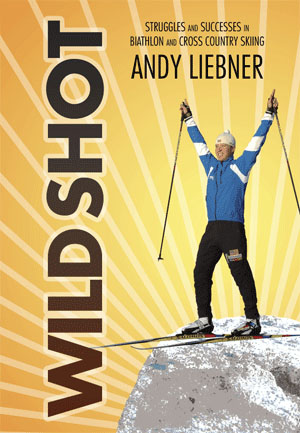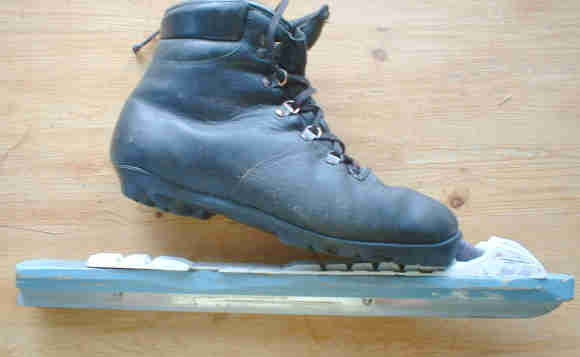[Here’s some rough wonderings about how to teach XC skiing so that it’s relevant to everyday skiers. I put word out for feedback about my following new/old theory amongst various authorities, including the PSIA. I’ll let you know if anyone ever replies.]
I recently checked out and examined all the how-to-xc-ski books that were ever commonly in print, plus some rare ones.
They all teach racer-type technique. That is, they teach diagonal, doublepole and kick-double-pole. These are the 3 gears for racers. Diag is for uphills, KDP for gradual uphills and DP for the flats. (H-bone is reserved for the really steeps.)
One big problem is that hardly any casual day-skiers or tourists are going to be racing! And they sure aren’t going to use DP very often on the flats!
What is the main goal for the short-distance day-skier? To see the sights and scenery, to enjoy the day, to chat with their friends and to enjoy some rhythmic kick’n’glide.
Such skiers all tend to use a similar style of skiing. They use an upright posture, a long arm outreach, and a slight scootering rhythm. It’s stable. You don’t have to pay much attention to the trail (when it’s not tricky). There’s a half-beat delay to the kick—thus it’s a very late kick. You reach your arm out, start poling, then kick as the pole goes past your hip. It doesn’t use complete weight transfer, or not for very long. The poling action isn’t very complete either—it stops doing much pushing near the hip and the kicking foot drops back into the track behind the gliding foot—but this gives a kind of stable telemark position. It’s “ride’n’glide”—you glide on your heels. This seems to be the default style of casual day-skiers.
AND IT WORKS!
And it is NOT taught, acknowledged or respected in the literature.
So let’s turn this around and show them that what they’re doing is a legit part of day-skier technique which fits in with a whole range of ski moves which are each great for certain situations.
The problem is that this day-skier technique has a couple problems.
It’s great for short-term cruising and sight-seeing on the flats, but it’s no good for uphills—it slips.
Also, your lower back can get sore when doing it for more than a couple hours and it can be more tiring in general because it uses smaller muscle groups than racer-tech.
Just as big of a problem as the slippage is that when self-taught day-skiers try to “go hard.” They lose the benefit and keep the faults. They bend over at the waist to get more arm-reach and lose the sight-seeing. They then REALLY slip on uphills and they REALLY wear out their lower back quick.
A last problem is that the day-skier is bad at ski-handling. Their weight is too far back. To be ready to handle your skis you need to drop down a bit into your ankles and flex them more and keep your hands in front, but not too far in front.
But the biggest problem of all is that “official pro” instructors try to get day-skiers to stop skiing like this ENTIRELY. They imitate “bad form” or what they consider to be common ski style, and go into a Frankenstein-robot-mummy-zombie mode with their legs stiffly marching and their arms outstretched and their butt back.
Now, suffering skiers do look bad like that, but the true day-skier tech that many competent self-taught enthusiasts use doesn’t look like that, yet it IS DIFFERENT from what the pro’s teach.
So what is going on???!!!
Our good self-taught day-skiers are using old-time wood ski technique!
And it’s at least part of the overall technique that used to be officially taught and published pre-1970’s/80’s.
But just because today’s skis are lighter and faster doesn’t mean the goal of the Day-Skiing Tourist has changed. It doesn’t mean that people have changed!
There’s a disconnect here! The official instructors are teaching race-style. But the regular folks have different needs!
Sure, racers now go faster, and they DP on the flats like lightning all day long—but hardly anyone is a racer. Plain folk need more options for the flats. Thankfully, they’re already using one! But they’re being told to stop! BAD IDEA! We need to EXPAND what we’re teaching and help explain the good aspects of what people are already doing.
Racing has 3 gears, but touring has more! Yet the extra moves aren’t being taught!
There used to be a lot more beats and timings taught because skis weighed more and there was time to get more moves in. Well, for day-skiers there’s still plenty of time. Many even still use wood skis! (…For cryin’ out loud!)
The easiest way to see what I mean is two-fold.
In skating there are 5 gears, for use in different terrain and for difference speeds, and they are all variations on timing and numbers of pole plants per kick. So skaters are already used to complexity in timing, even if they don’t think about it. There’s diag-skate, V1, V2, V2A, and no-pole.
But in truth, there are even more skate gears. The Delay-Kick or Hang V1 (there are even a couple other names for it, skier names, which aren’t descriptive and require you to know the style of old skiers) is a very popular style used by many citizen fun-level skaters—for what?—for cruising on the flats and enjoying the sights! It’s an easy, relaxed, stable, and UPRIGHT technique—but, interestingly, it is not taught in any books! It is, however, mentioned in some elite material. What you do is do your V1 poling THEN kick. Normal V1 has you kick with the poling. This Hang V1 is the skate equivalent of the Basic Day-Skier Tech!
Skaters already know that they can mess with their timing or merge their timings from one style to another as they change-up or even change directions as the trail winds along. They’re used to it. They don’t even have to name these moves or think about them. At the same time, these variants aren’t taught, not very often anyway.
What’s NOT well known AT ALL is that timing can be legitimately played with in classic skiing as well.
A couple side points before I get to the 2nd part of my main point… : )
Skating actually isn’t different from diagonal. Skating has more fudge room for when you CAN kick, but actually there’s no greater fudge room for when you SHOULD kick…which is when your weight is completely transferred and when you’re standing up (no toilet seat). The timing is up to you. The difference between skating and classic is that you kick to the side not to the back, and the ski is moving while you kick.
Also, they say that classic is tricky because the ski STOPS while it grips. Well, the POLES stop in all cases of skiing. In diagonal you just stop a ski PLUS a pole. No big deal. The only reasons why skating is faster is because there’s no kickwax drag—which is slight—and there are 2 propulsion vectors instead of just 1—but there is also a loss because the skis aren’t gliding strictly forward as they do in classic. The upshot is that skating is only 10% faster in World Cup racing, but that’s not relevant to day-skiers of either ilk. What is relevant is that in skating you can’t miss your kick—but you CAN flounder and go slow.
Back to my main point.
Another easy way to see a legit role for messing with classic day-skier timing is in the kick double-pole (KDP). There used to be a *TWO*-kick DP. Well, it’s still out there and it’s still a fun move and a natural one for some day-skiers. But they may well think they’re doing something wrong when they try it, and so tend to avoid it, that is, if they’ve ever had a “real” lesson. (That’s crazy!) To do it, you take one step and then another and kick into the double-poling action off the 2nd step. Easy!
Heck, in the old days, ski moves were actually called “steps” in some instances. I say we revive that!
I say we should revive the wood-ski techniques as well!
I also note that in other languages the ski moves are called “dances.” And everyone knows that dancing has LOTS of kinds of timing as long as it’s rhythmic.
There’s another good old wood-ski technique called the Pendulum Pole. That’s where you pump your hands in front of you as you step. Basically, you just skip planting your pole for a beat and do a kick without a pole. Your hands “scissor” in front. Then you’re right in time to pole for the next kick, or step.
So there are at least 2 ways of kicking without poling for a beat.
I have a 1977 German translation book that shows pendulum and 2-KDP moves. Plus I have a lovely book, “Expert Skiing,” from 1960 that gives some alternate beat info. It was real then and it’s real now.
Then there are transition moves or change-ups. This is hardly ever taught, not even in race clinics. It’s assumed that you’ll just sort it out. But whenever we do a change-up, we mess with timing.
So…you can pole then kick in the Hang-V1. And you can do all kinds of kicking without poling in old-style classic. Well, I say that means that you can feel free to pole then kick a half-beat later in your diagonal classic if you feel like it! It’s not a bad thing! Sure, it’s sometimes called “late kick”—well, a delay is not always late! Our half-beat delay-kick in classic is perfectly fine for flat, mellow terrain and it lets us use an upright posture that’s great for sight-seeing and conviviality.
The upshot is let’s give respect to how competent self-taught people are already skiing. And don’t try to tell day-skiers that the only right way is a system not designed for them!
Instead, help them to understand what they’re already doing. If they enjoy skiing they’re already using a rhythm and a timing. …One of many!
Let them know that they can mess FURTHER with their timing.
Then show them that to get grip on uphills they have to bring their timing TOGETHER and get total weight transfer. This will give them more umph in their kick and more relaxation from their glide—without using any more energy. Great!
(Do this via the “jog uphill without glide” and the no-poles drills, both of which will get them hopping from foot to foot and timing their hands exactly with their feet, with total weight transfer.)
If they want to go fast or far, and use their big muscles in a wider range of motion, and save their lower-back, show them how to stand up and drive with their hips and tip forward (via the “tipping” drill without skis) and via double-poling with bent arms and no arm-extension to show them that a bent-arm plant and forward hip are their friends.
They can also try using the Russian Technique (a la the Anikins) and adopt a forward posture PLUS long arms AND heel-riding to good effect in some situations and as a break/rest from other methods.
The world is THEIR oyster. They need to know that they can play with all this stuff, and use it where it fits…for them.
I want to make a quick, short YouTube video that shows all this stuff…
I need to distill this idea into a 5-minute lesson…




